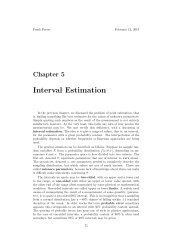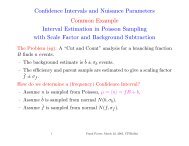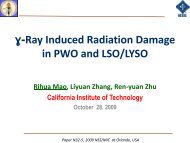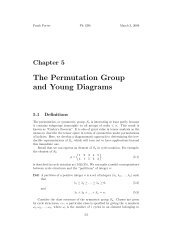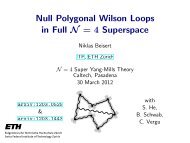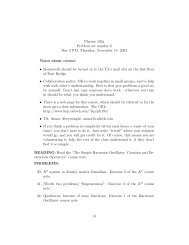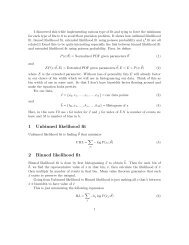1 Introduction 2 Resolvents and Green's Functions
1 Introduction 2 Resolvents and Green's Functions
1 Introduction 2 Resolvents and Green's Functions
Create successful ePaper yourself
Turn your PDF publications into a flip-book with our unique Google optimized e-Paper software.
y<br />
z<br />
y<br />
-y 0<br />
0<br />
x<br />
Figure 5: The region of convergence of the perturbation series is the unshaded<br />
area.<br />
V = V (x) is a potential function, <strong>and</strong> ¯H = H + V . Then the identity<br />
Ḡ(z) = G(z) − G(z)V Ḡ(z) (114)<br />
corresponds to the integral equation:<br />
∫<br />
Ḡ(x, y; z) = G(x, y; z) −<br />
(∞)<br />
d 3 (x ′ )G(x, x ′ ; z)V (x ′ )Ḡ(x′ , y; z), (115)<br />
<strong>and</strong><br />
Ḡ(z) = G(z) − G(z)V G(z) + G(z)V Ḡ(z)V G(z) (116)<br />
corresponds to:<br />
∫<br />
Ḡ(x, y; z) = G(x, y; z) − d 3 (x ′ )G(x, x ′ ; z)V (x ′ )G(x ′ , y; z) (117)<br />
(∞)<br />
∫ ∫<br />
+ d 3 (x ′ )d 3 (y ′ )G(x, x ′ ; z)V (x ′ )Ḡ(x′ , y ′ ; z)V (y ′ )G(y ′ , y; z),<br />
(∞)<br />
where z /∈ Σ(H), z /∈ Σ( ¯H).<br />
We can also express the Schrödinger Equation for eigenstates of the perturbed<br />
Hamiltonian in the form of an integral equation. Let ¯φ k be an<br />
eigenstate of ¯H, corresponding to eigenvalue ¯ωk . Use the identity Ḡ(z) =<br />
G(z) − G(z)V Ḡ(z), <strong>and</strong> operate on ¯φ k , noting that (¯ω k − z)Ḡ(z) ¯φ k = ¯φ k :<br />
¯φ k = (¯ω k − z)G(z) ¯φ k − G(z)V ¯φ k . (118)<br />
19




